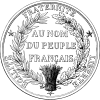French Republic République française (French) | |||||||||||||
|---|---|---|---|---|---|---|---|---|---|---|---|---|---|
| 1946–1958 | |||||||||||||
| Motto: "Liberté, égalité, fraternité" "Liberty, Equality, Fraternity" | |||||||||||||
| Anthem: "La Marseillaise" | |||||||||||||
| Great Seal: | |||||||||||||
 | |||||||||||||
| Capital and largest city | Paris 48°51′N 2°21′E / 48.850°N 2.350°E | ||||||||||||
| Official language | French | ||||||||||||
| Religion | Secular state[a]
In Alsace-Moselle: | ||||||||||||
| Demonym(s) | French | ||||||||||||
| Government | Unitary parliamentary republic | ||||||||||||
| President | |||||||||||||
• 1947–1954 | Vincent Auriol | ||||||||||||
• 1954–1959 | René Coty | ||||||||||||
| Prime Minister | |||||||||||||
• 1947 (first) | Paul Ramadier | ||||||||||||
• 1958–1959 (last) | Charles de Gaulle | ||||||||||||
| Legislature | Parliament | ||||||||||||
| Council of the Republic | |||||||||||||
| National Assembly | |||||||||||||
| Historical era | |||||||||||||
| 13 October 1946 | |||||||||||||
• Constitution adopted | 27 October 1946 | ||||||||||||
| 17 March 1948 | |||||||||||||
| 13 March 1954 | |||||||||||||
| 1 November 1954 | |||||||||||||
| 29 October – 7 November 1956 | |||||||||||||
| 13 May 1958 | |||||||||||||
| 28 September 1958 | |||||||||||||
• New constitution adopted | 4 October 1958 | ||||||||||||
| Currency | |||||||||||||
| |||||||||||||
| Today part of | France Algeria | ||||||||||||
The French Fourth Republic (French: Quatrième république française) was the republican government of France from 27 October 1946 to 4 October 1958, governed by the fourth republican constitution of 13 October 1946. Essentially a reestablishment and continuation of the French Third Republic which governed from 1870 during the Franco-Prussian War to 1940 during World War II, it suffered many of the same problems which led to its end. The French Fourth Republic was a parliamentary republic.
Despite political dysfunction, the Fourth Republic saw an era of great economic growth in France and the rebuilding of the nation's social institutions and industry after World War II, with assistance from the United States through the Marshall Plan. It also saw the beginning of the rapprochement with France's longtime enemy Germany, which led to Franco-German co-operation and eventually to the European Union.
The new constitution made some attempts to strengthen the executive branch of government to prevent the unstable situation before the war, but instability remained and the French Fourth Republic saw frequent changes of government – there were 21 administrations in its 12-year history. Moreover, the government proved unable to make effective decisions regarding decolonization of the numerous remaining French colonies. After a series of crises culminating in the Algerian crisis of 1958, the French Fourth Republic collapsed. Wartime leader Charles de Gaulle returned from retirement to preside over a transitional administration empowered to design a new French constitution. The Fourth Republic was dissolved on 5 October 1958 following a public referendum which established the current French Fifth Republic with a strengthened presidency.
Cite error: There are <ref group=lower-alpha> tags or {{efn}} templates on this page, but the references will not show without a {{reflist|group=lower-alpha}} template or {{notelist}} template (see the help page).



